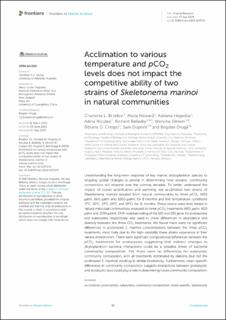| dc.contributor.author | Briddon, Charlotte L. | |
| dc.contributor.author | Nicoară, Maria | |
| dc.contributor.author | Hegedüs, Adriana | |
| dc.contributor.author | Niculea, Adina | |
| dc.contributor.author | Bellerby, Richard | |
| dc.contributor.author | Eikrem, Wenche | |
| dc.contributor.author | Gomez Crespo, Bibiana | |
| dc.contributor.author | Dupont, Sam | |
| dc.contributor.author | Drugă, Bogdan | |
| dc.date.accessioned | 2023-11-14T13:32:51Z | |
| dc.date.available | 2023-11-14T13:32:51Z | |
| dc.date.created | 2023-09-25T18:32:50Z | |
| dc.date.issued | 2023 | |
| dc.identifier.citation | Frontiers in Marine Science. 2023, 10:1197570. | en_US |
| dc.identifier.issn | 2296-7745 | |
| dc.identifier.uri | https://hdl.handle.net/11250/3102508 | |
| dc.description.abstract | Understanding the long-term response of key marine phytoplankton species to ongoing global changes is pivotal in determining how oceanic community composition will respond over the coming decades. To better understand the impact of ocean acidification and warming, we acclimated two strains of Skeletonema marinoi isolated from natural communities to three pCO2 (400 μatm, 600 μatm and 1000 μatm) for 8 months and five temperature conditions (7°C, 10°C, 13°C, 16°C and 19°C) for 11 months. These strains were then tested in natural microbial communities, exposed to three pCO2 treatments (400 μatm, 600 μatm and 1000 μatm). DNA metabarcoding of the 16S and 18S gene for prokaryotes and eukaryotes respectively was used to show differences in abundance and diversity between the three CO2 treatments. We found there were no significant differences in acclimated S. marinoi concentrations between the three pCO2 treatments, most likely due to the high variability these strains experience in their natural environment. There were significant compositional differences between the pCO2 treatments for prokaryotes suggesting that indirect changes to phytoplankton-bacteria interactions could be a possible driver of bacterial community composition. Yet, there were no differences for eukaryotic community composition, with all treatments dominated by diatoms (but not the acclimated S. marinoi) resulting in similar biodiversity. Furthermore, strain-specific differences in community composition suggests interactions between prokaryotic and eukaryotic taxa could play a role in determining future community composition. | en_US |
| dc.language.iso | eng | en_US |
| dc.publisher | Frontiers | en_US |
| dc.rights | Navngivelse 4.0 Internasjonal | * |
| dc.rights.uri | http://creativecommons.org/licenses/by/4.0/deed.no | * |
| dc.title | Acclimation to various temperature and pCO2 levels does not impact the competitive ability of two strains of Skeletonema marinoi in natural communities | en_US |
| dc.type | Peer reviewed | en_US |
| dc.type | Journal article | en_US |
| dc.description.version | publishedVersion | en_US |
| dc.rights.holder | © 2023 The Authors | en_US |
| dc.source.pagenumber | 15 | en_US |
| dc.source.volume | 10 | en_US |
| dc.source.journal | Frontiers in Marine Science | en_US |
| dc.identifier.doi | 10.3389/fmars.2023.1197570 | |
| dc.identifier.cristin | 2178738 | |
| dc.source.articlenumber | 1197570 | en_US |
| cristin.ispublished | true | |
| cristin.fulltext | original | |
| cristin.qualitycode | 1 | |

